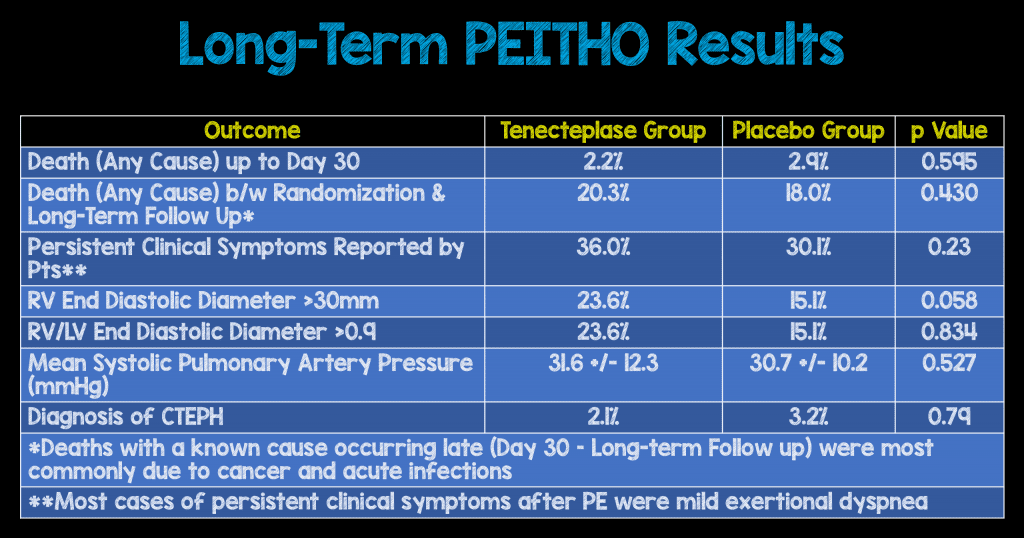
 Background: There has been very little robust evidence published on the long-term outcomes of systemic thrombolysis in acute submassive PE. Many advocate for the use of systemic thrombolysis to reduce morbidity (complications from chronic pulmonary hypertension) and mortality. The PEITHO trial compared systemic thrombolysis (with tenecteplase + heparin) vs no systemic thrombolysis (placebo + heparin) in just over 1000 patients with confirmed PE, RV dysfunction, and positive troponins. The primary outcome of all-cause death or hemodynamic decompensation within 7 days occurred less frequently in the thrombolysis arm. This statistically significant difference was driven by differences in hemodynamic decompensation, not mortality – a non-patient centered outcome. Additionally, the benefit was at the risk of increased intracranial hemorrhage. In this current study, 70% of the patients from the original PEITHO trial were followed for a 2-year follow up period, giving us some information about long-term sequelae of systemic thrombolysis in patients with submassive PE.
Background: There has been very little robust evidence published on the long-term outcomes of systemic thrombolysis in acute submassive PE. Many advocate for the use of systemic thrombolysis to reduce morbidity (complications from chronic pulmonary hypertension) and mortality. The PEITHO trial compared systemic thrombolysis (with tenecteplase + heparin) vs no systemic thrombolysis (placebo + heparin) in just over 1000 patients with confirmed PE, RV dysfunction, and positive troponins. The primary outcome of all-cause death or hemodynamic decompensation within 7 days occurred less frequently in the thrombolysis arm. This statistically significant difference was driven by differences in hemodynamic decompensation, not mortality – a non-patient centered outcome. Additionally, the benefit was at the risk of increased intracranial hemorrhage. In this current study, 70% of the patients from the original PEITHO trial were followed for a 2-year follow up period, giving us some information about long-term sequelae of systemic thrombolysis in patients with submassive PE.
Episode 38 – Do All Submassive PE’s Require Treatment with Thrombolysis?
Click here for Direct Download of Podcast
What They Did:
- Study of the long-term prognosis of patients from the PEITHO (Pulmonary Embolism Thrombolysis) Trial, which was a randomized (1:1) comparison of thrombolysis with tenecteplase versus placebo in normotensive patients with acute PE, RV dysfunction on imaging, and positive cardiac troponin (i.e. submassive PE)
- PEITHO was a multicenter, double-blind, placebo-controlled randomized trial
Outcomes:
- Long-term mortality
- Clinical and Echocardiographic parameters
Inclusion:
- ≥18 years of age
- Confirmed acute PE with first symptoms ≤15d
- RV dysfunction (Diagnosed by echocardiography or computed tomography)
- Myocardial injury (Diagnosed by positive troponin I or T)
Results from the Original PEITHO Trial:

BOTTOM LINE: 7-day death and hemodynamic compromise was decreased (important to note that hemodynamic compromise drove this difference) with systemic thrombolysis at the cost of increased extracranial and intracranial hemorrhage in patients with intermediate-risk PE.
Results:
- 709 patients included in long-term follow up (>70% of original study)
- Median Follow up Period: 37.8 months
- Overall Mortality Rate: 19.2%

Strengths:
- Multicenter, double-blind randomized control trial
- Largest patient population to date answering an important patient oriented outcome
- There was no real baseline differences in patients followed long-term vs those not followed long term with two exceptions:
- Body weight: 81.8 +/- 17.9kg vs 84.4 +/- 18.3kg
- History of previous VTE: 25% vs 32.4%
Limitations:
- Many causes of late death (beyond 30 days) were not able to be identified
- Clinical and echocardiographic evaluation could not be performed on all survivors. Therefore, this data cannot be considered the definitive evidence of how often pulmonary hypertension or RV dysfunction persists after acute PE
- The rate of CTEPH after acute PE was low (2.7%), which is lower than rates observed in earlier cohort studies
- The diagnostic algorithm for suspected CTEPH was not part of the original PEITHO trial protocol
Discussion:
- In the discussion portion of the paper the authors comment that previous studies as well as their own show that most deaths that occurred after the initial 30 days of diagnosis of acute PE were from comorbid or underlying conditions, not from progressive right-sided heart failure. This may be why thrombolysis has not been shown to decrease long-term mortality.
- Mortality is not the only outcome that is important. Reduction in pulmonary hypertension or RV dysfunction would also be important patient oriented outcomes. Previous studies have been rather small looking at these outcomes which why there has been much controversy with the use of thrombolysis. In this current study, the majority of persistent clinical symptoms were mild in 1/3 of the patients evaluated and there was no indication that early thrombolysis improved the severity of symptoms, functional status, or echocardiographic parameters in the long-term period.
Author Conclusion: “Approximately 33% of patients report some degree of persistent functional limitation after intermediate-risk PE< but CTEPH is infrequent. Thrombolytic treatment did not affect long-term mortality rates, and it did not appear to reduce residual dyspnea or RV dysfunction in these patients.”
Clinical Take Home Point: In the current trial, long-term mortality rates and long-term morbidity (residual dyspnea, functional limitations, and persistent RV dysfunction) were not affected by the use of systemic thrombolysis in unstratified patients with submassive PE. Thrombolysis in submassive PE should now only be considered in patients with signs of submassive PE and either at risk of throwing additional emboli to the lungs (proximal DVT or clot in transit on echo) or patients who appear to be at the brink of massive PE (pale, diaphoretic).
References:
- Konstantinides SV et al. Impact of thrombolytic Therapy on the Long-Term Outcome of Intermediate-Risk Pulmonary Embolism. J Am Coll Cardiol 2017; 69: 1536 – 44. PMID: 28335835
For More Thoughts on This Topic Checkout:
- Rory Spiegel at EM Nerd (EMCrit): The Case of the Shadowy Spector
- Josh Farkas at PulmCrit (EMCrit): Submassive PE 2017 – Getting ‘em off the Cliff
- Salim Rezaie at ALiEM: PEITHO Trial – Fibrinolysis for Intermediate-Risk Pulmonary Embolism
- Anand Swaminathan at St. Emlyn’s Blog: The Argument for Systemic Thrombolytics in Submassive Pulmonary Embolism
- Ken Milne at The SGEM: SGEM #184 – We Weren’t Born to Follow-Up – The PEITHO Long-Term Follow-Up Study
Post Peer Reviewed By: Anand Swaminathan (Twitter: @EMSwami)
The post Episode 38 – Do All Submassive PE’s Require Treatment with Thrombolysis? appeared first on REBEL EM - Emergency Medicine Blog.
